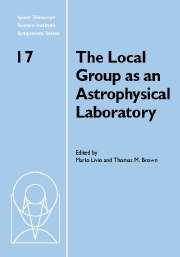 The Local Group as an Astrophysical Laboratory
The Local Group as an Astrophysical Laboratory Published online by Cambridge University Press: 12 May 2010
Planetary Nebulae (PNs) in the Magellanic Clouds offer the unique opportunity to study both the population and evolution of low- and intermediate-mass stars, in an environment that is free of the distance scale bias and the differential reddening that hinder the observations of the Galactic sample. The study of LMC and SMC PNs also offers the direct comparison of stellar populations with different metallicity. The relative proximity of the Magellanic Clouds allows detailed spectroscopic analysis of the PNs therein, while the Hubble Space Telescope (HST) is necessary to obtain their spatially-resolved images. In this paper we discuss the history and evolution of this relatively recent branch of stellar astrophysics by reviewing the pioneering studies, and the most recent ground- and space-based achievements. In particular, we present the results from our recent HST surveys, including the metallicity dependence of PN identification (and, ultimately, the metallicity dependence of PN counts in galaxies); the morphological analysis of Magellanic PNs, and the correlations between morphology and other nebular properties; the relations between morphology and progenitor mass and age; and the direct analysis of Magellanic central stars and their importance to stellar evolution. Our morphological results are broadly consistent with the predictions of stellar evolution if the progenitors of asymmetric PNs have on average larger masses than the progenitors of symmetric PNs, without any assumption or relation to binarity of the stellar progenitors.
Introduction
Planetary Nebulae (PNs) are the gaseous relics of the envelopes ejected by low- and intermediate-mass stars (1 < M < 8 M⊙) at the tip of the asymptotic giant branch (AGB), thus they are important probes of stellar evolution, stellar populations, and cosmic recycling.
To save this book to your Kindle, first ensure [email protected] is added to your Approved Personal Document E-mail List under your Personal Document Settings on the Manage Your Content and Devices page of your Amazon account. Then enter the ‘name’ part of your Kindle email address below. Find out more about saving to your Kindle.
Note you can select to save to either the @free.kindle.com or @kindle.com variations. ‘@free.kindle.com’ emails are free but can only be saved to your device when it is connected to wi-fi. ‘@kindle.com’ emails can be delivered even when you are not connected to wi-fi, but note that service fees apply.
Find out more about the Kindle Personal Document Service.
To save content items to your account, please confirm that you agree to abide by our usage policies. If this is the first time you use this feature, you will be asked to authorise Cambridge Core to connect with your account. Find out more about saving content to Dropbox.
To save content items to your account, please confirm that you agree to abide by our usage policies. If this is the first time you use this feature, you will be asked to authorise Cambridge Core to connect with your account. Find out more about saving content to Google Drive.